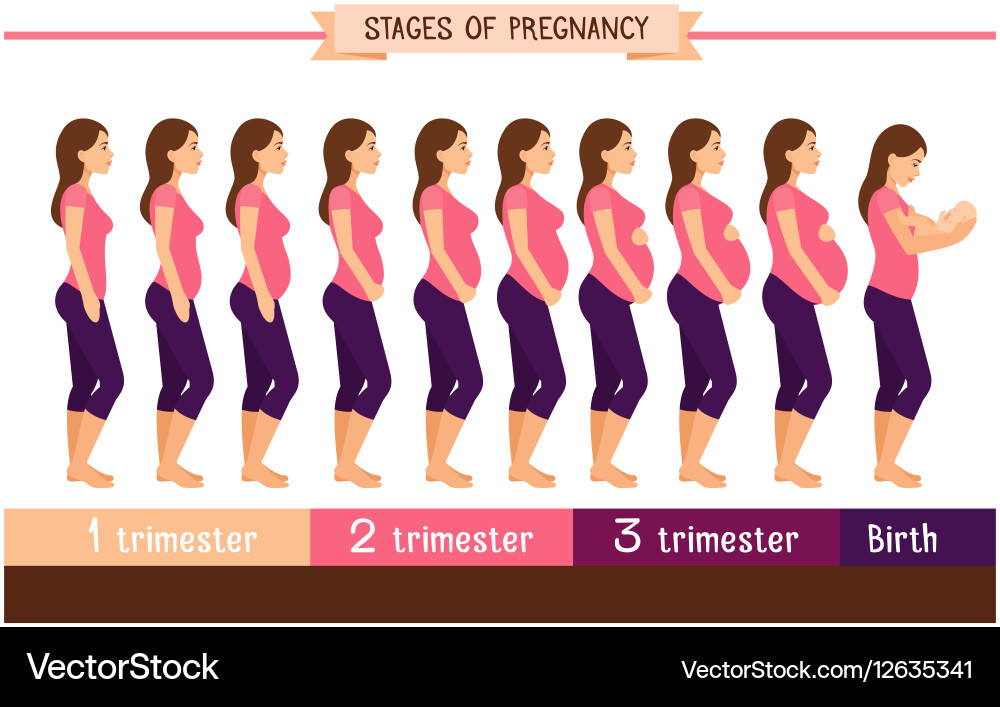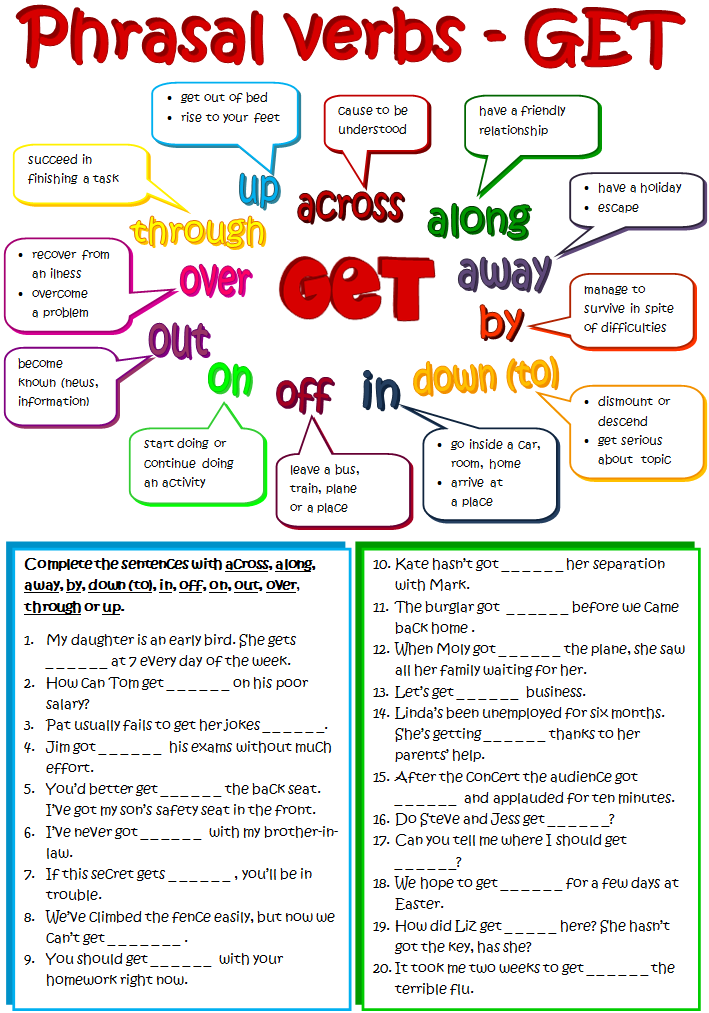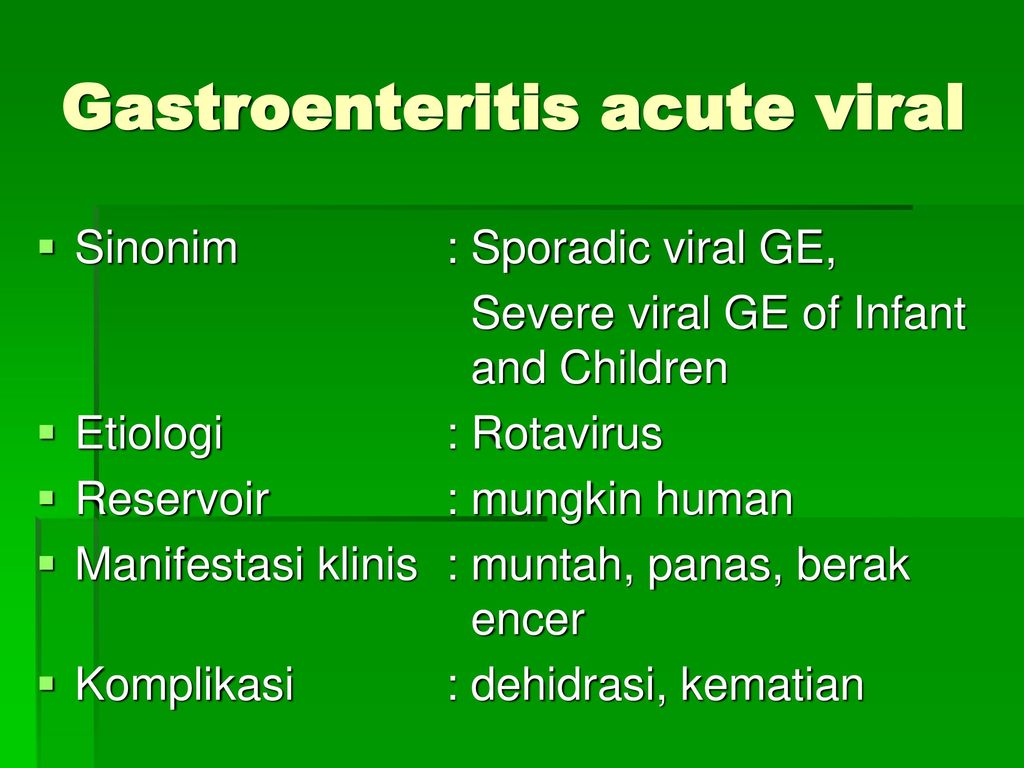Normal baby temp under armpit
How to take a newborn’s temperature
Your best bet is to use a digital thermometer. These can be bought inexpensively in any supermarket or pharmacy and can be used to take rectal (in the bottom) or axillary (in the armpit) temperature readings.
Taking a rectal temperature gives the most accurate reading of body temperature in infants and young children. However, if the thought of doing this makes you squeamish, taking an axillary temperature is the next best choice.
Be aware that temperature strips, which are placed on someone's forehead for a reading, have been found to be poor indicators of true body temperature, especially in infants and children, and should be avoided. The digital thermometer is best for temperature taking at home.
Taking a rectal temperature
- Lubricate the tip of the thermometer with a lubricating jelly. Check the manufacturer's directions to see whether water-soluble jelly or petroleum jelly is recommended.
- Place your baby on a firm, flat surface such as a changing table.
- Using your hand, insert the lubricated thermometer through the anal opening, about one-half to one inch or about 1.25 to 2.5 centimeters into the rectum. Stop at less than ½ inch or about 1.25 centimeters if you feel any resistance.
- Steady the thermometer between your second and third fingers as you cup your hand against your baby's bottom. Soothe your baby and speak to him/her quietly as you hold the thermometer in place.
- Wait until you hear the appropriate number of beeps or other signal that the temperature is ready to be read. Read and record the number on the screen, noting the time of day that the reading was taken.
Taking an axillary temperature
- Remove your child's shirt and undershirt. The thermometer should touch skin only, not clothing.
- Insert the thermometer in your child's armpit. Fold your child's arm across his chest to hold the thermometer in place.

- Wait until you hear the appropriate number of beeps or other signal that the temperature is ready to be read. Read and record the number on the screen, noting the time of day that the reading was taken.
Additional tips
- Never take your baby's temperature right after a bath or if he/she has been bundled tightly for a while — this can affect the temperature reading
- Never leave a child unattended while taking his temperature
- Temperature should be taken only if the baby feels hot or is lethargic
- A baby's normal temperature range:
- Under the arm is 97.5 to 99.3 degrees Fahrenheit or 36.5 to 37.4 degrees Celsius
- Rectal is 100.2 degrees Fahrenheit or less, or 37.9 degrees Celsius or less
- These are the American Academy of Pediatrics recommended ranges. If you have questions or concerns, be sure to discuss them with your baby's healthcare provider
Download the printable version of this page (PDF)
How to Take a Temperature (0-12 Months)
When Does Your Baby Have a Fever??
- Average body temperature is around 98.
 6° F (37.0° C)
6° F (37.0° C) - A fever is an elevated body temperature with these readings:
- Rectal, Forehead or Ear temperature: 100.4° F (38.0° C) or higher
- Under the arm (armpit) temperature: 99° F (37.2° C) or higher
- Caution: ear temperatures are not accurate before 6 months of age
Where to Take the Temperature
- Rectal temps are the most accurate. Forehead temps are the next most accurate. Ear temps are also accurate if done properly. Temps done in the armpit are the least accurate. Armpit temps are useful for screening at any age.
- Age under 3 months old (90 days old). An armpit temp is the safest and is good for screening. If the armpit temp is above 99° F (37.2° C), re-check it. Use a rectal reading. Reason: If young babies have a fever, they need to see a doctor now. New research shows that forehead temps may also be accurate under 3 months of age.
- Age 3 months to 1 year old. Rectal or forehead temps are accurate.
 An ear thermometer can be used after 6 months old. An armpit temp is good for screening if it is taken right.
An ear thermometer can be used after 6 months old. An armpit temp is good for screening if it is taken right. - Digital (electronic) thermometers are easily found in stores. They do not cost very much. They can be used for rectal and armpit temps. Most of them give an accurate temp in 10 seconds or less. The AAP suggests you replace any glass thermometer in the house with one of these products.
Rectal Temperature: How to Take
- Age: Birth to 1 year old
- Have your child lie stomach down on your lap. Another way is on the back with the legs pulled up to the chest.
- Put some petroleum jelly on the end of the thermometer and the anus.
- Slide the thermometer gently into the anus no more than 1 inch. If your child is less than 6 months old, put it in no more than ½ inch. That means until you can no longer see the silver tip.
- Be gentle. There should not be any resistance. If there is, stop.
- Hold your child still. Leave a digital thermometer in until it beeps (about 10 seconds).

- Your child has a fever if the rectal temp is above 100.4° F (38° C).
- Warning: do not take rectal temperatures in young children with leukemia or other cancers. Also avoid in other children with weak immune systems such as organ transplant, HIV or sickle cell disease.
Armpit Temperature: How to Take
- Age: Any age for screening
- Put the tip of the thermometer in an armpit. Make sure the armpit is dry.
- Close the armpit by holding the elbow against the chest. Do this until it beeps (about 10 seconds). The tip of the thermometer must stay covered by skin.
- Your child has a fever if the armpit temp is above 99.0° F (37.2° C). If you have any doubt, take your child's temp by rectum or forehead.
Ear Temperature: How to Take
- Age: 6 months and older (not accurate before 6 months)
- This thermometer reads the heat waves coming off the eardrum.
- A correct temp depends on pulling the ear backward. Pull back and up if over 1 year old.

- Then aim the tip of the ear probe between the opposite eye and ear.
- Parents like this thermometer because it takes less than 2 seconds. It also does not need the child to cooperate. It does not cause any discomfort.
- Caution. Being outdoors on a cold day will cause a low reading. Your child needs to be inside for 15 minutes before taking the temp. Earwax, ear infections and ear tubes do not keep from getting correct readings.
Forehead Touch Temperature: How to Take
- Age: Any age
- This thermometer reads the heat waves coming off the temporal artery. This blood vessel runs across the forehead just below the skin.
- This is the one most used in hospitals and doctors’ offices.
- Place the sensor head at the center of the forehead touching the skin.
- Slowly slide the thermometer across the forehead toward the top of the ear. Keep it in contact with the skin.
- Stop when you reach the hairline.
- Read your child's temp on the display screen.
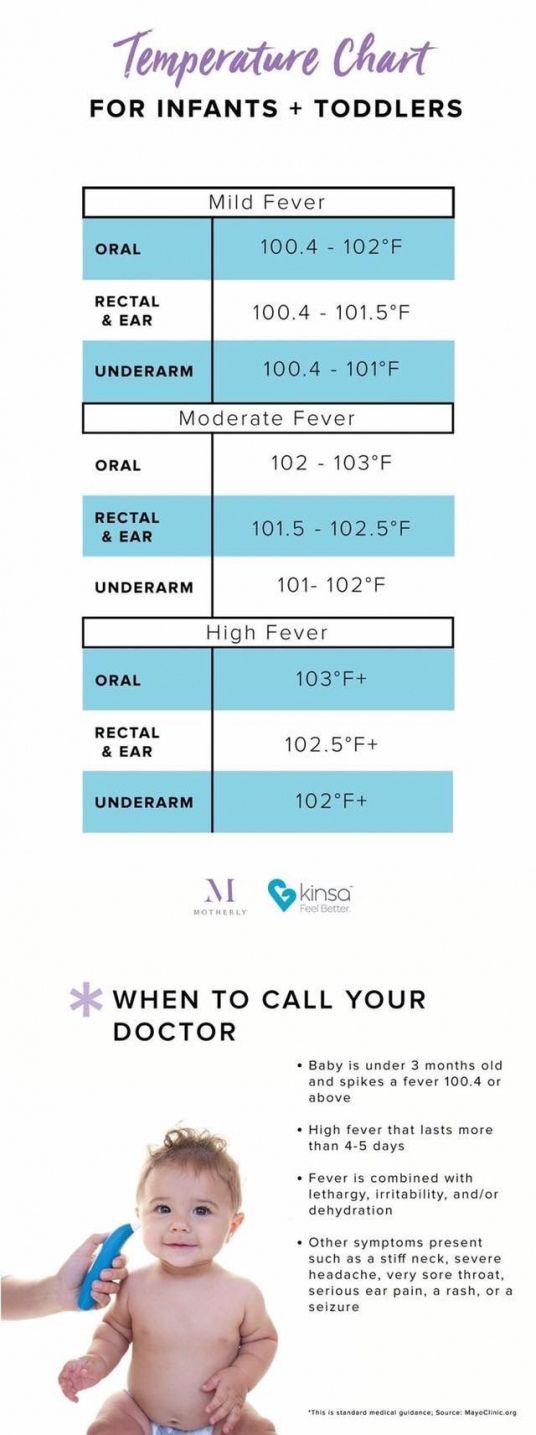
- Note: some newer forehead thermometers don't need to slide across the forehead. Follow the box directions on how to take the temp.
- Used in more doctor's offices than any other thermometer.
- Parents like this thermometer because it takes less than 2 seconds. It also does not need the child to cooperate. It does not cause any discomfort.
- Caution: forehead temperatures must be digital. Forehead strips are not accurate.
Forehead No-Touch Temperature: How to Take
- Age: any age
- Aim the thermometer at the center of the forehead.
- Stay less than 1 inch (2.5 cm) away. Do not touch the forehead.
- Do not move the thermometer.
- Press the measurement button.
If your child’s illness or injury is life-threatening, call 911.
- Bellevue
- Everett
- Federal Way
- Seattle
- Virtual Urgent Care
Last Reviewed: 03/16/2023
Last Revised: 01/26/2023
Copyright 2000-2023 Schmitt Pediatric Guidelines LLC.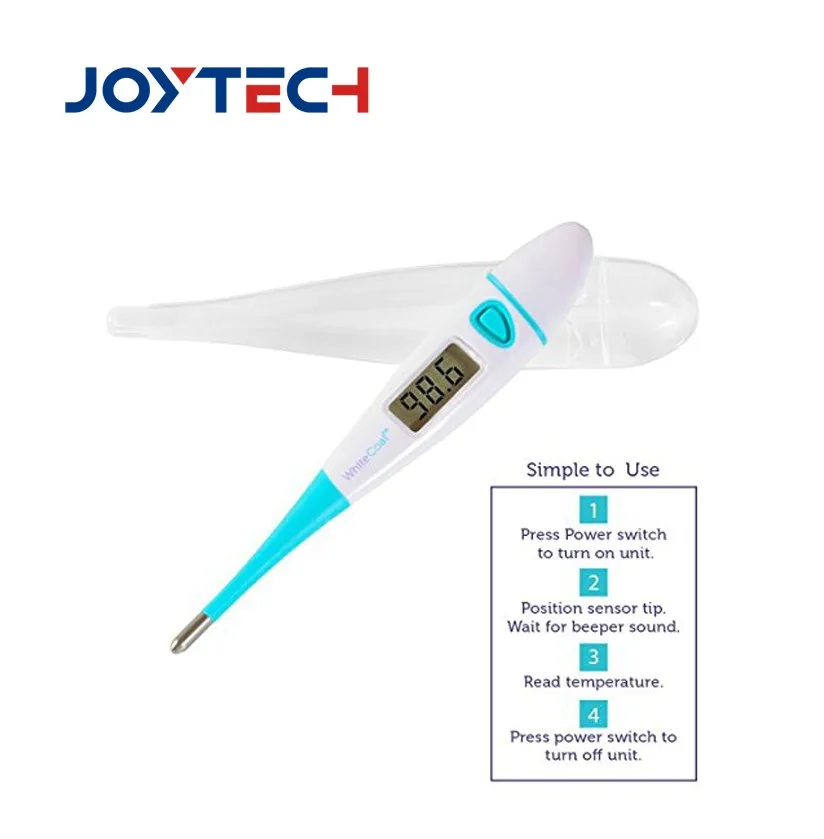
Normal values of body temperature in children, measurement of the child's body temperature
It is believed that a healthy child should have a body temperature of 36.6 °C. And its increase over 37 degrees is regarded as a sign of illness. But it is not so.
Body temperature depends on age and measurement area. It can increase after physical exertion, emotional arousal and feeding.
Devices and time for measuring body temperature
To determine the temperature, the following types of thermometers are used:
-
digital;
-
mercury;
-
infrared.
The optimal time for thermometry is 7-9 am and 17-19 pm. As prescribed by the doctor, the determination of the temperature during the day in children can be performed 3-4 times.
What temperature is considered normal for a child?
Immediately after the birth of a newborn, the temperature of his body decreases by 1-2 ° C, then within 24 hours it rises to 36-37 ° C. In the first 3 months of a baby's life, its indicators are unstable and depend on external factors: air temperature in the room, sleep, food intake. Normally, these fluctuations do not exceed 0.6 °C per day. For children of the first year of life, a temperature of 37.7 is the norm.
In the first 3 months of a baby's life, its indicators are unstable and depend on external factors: air temperature in the room, sleep, food intake. Normally, these fluctuations do not exceed 0.6 °C per day. For children of the first year of life, a temperature of 37.7 is the norm.
The average body temperature for a child is 37°C. Usually in the morning - 36.3 ° C, and in the evening it can rise to 37.6 ° C.
In what areas can the temperature of children be taken?
Underarm
The temperature measurement time under the arm is 5-10 minutes and depends on the type of device.
In the rectum
It is used in children under 5 years of age and in debilitated patients. For this method, it is desirable to use medical electronic thermometers with a soft tip. It will take 1-1.5 minutes to determine the rectal temperature.
Oral
The procedure is performed both under the tongue and behind the cheek. Contraindications to the use of this method are: children under 4-5 years of age, increased excitability and impaired nasal breathing. The duration of temperature measurement by the oral method is from 10 seconds to 3 minutes.
Contraindications to the use of this method are: children under 4-5 years of age, increased excitability and impaired nasal breathing. The duration of temperature measurement by the oral method is from 10 seconds to 3 minutes.
In the ear
The temperature in the ear is measured with an infrared sensor. The tip of the thermometer is inserted into the ear canal and the result appears on the display.
On forehead
Forehead temperature can be measured with a contact and non-contact thermometer. It will take 3 to 5 seconds to get the result. If the baby is sleeping or excited, then it is more convenient to use a non-contact method for measuring temperature.
Crotch
Mainly used in infants. The measurement time in the inguinal fold is 5 minutes. The method is inconvenient because the baby is not easy to keep in one position during this time.
Ranges of normal temperature in children depending on age and area of measurement are presented in the following table:
| 0-2 years | 3-10 years | 11-18 years old | |
|---|---|---|---|
| In the armpit | 34.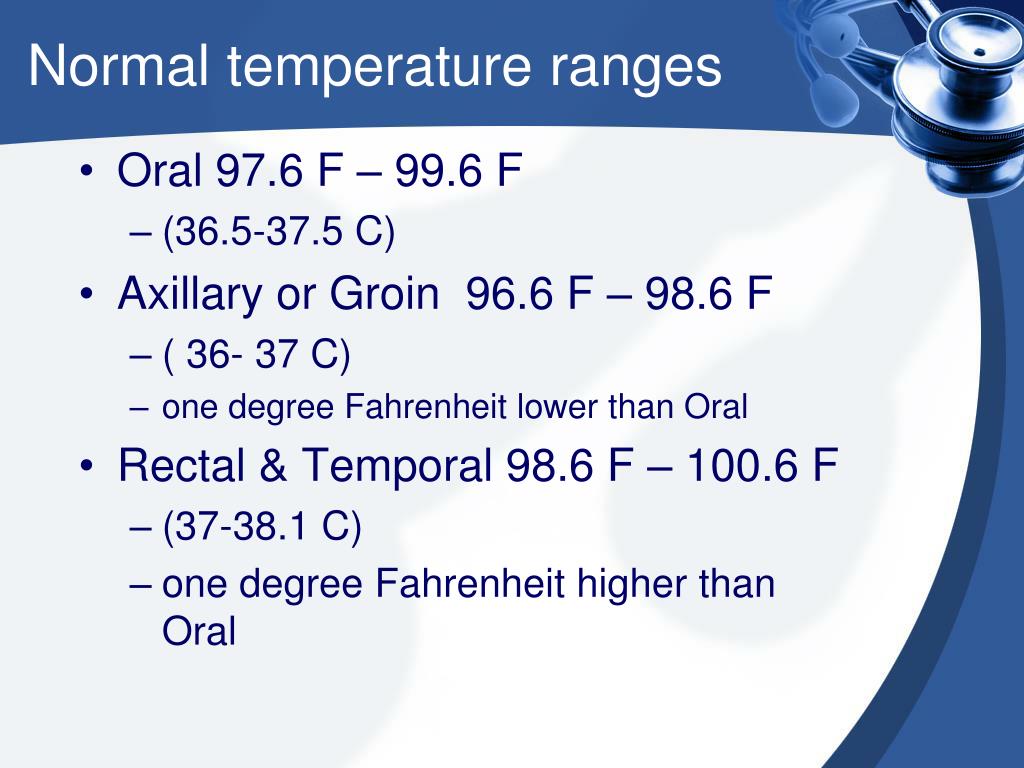 7 - 37.2 7 - 37.2 | 35.8 - 36.6 | 35.1 - 36.8 |
| On the forehead | 36.7 - 37.5 | 36.7 - 37.5 | 36.5 - 37.4 |
| in the ear | 36.3 - 37.7 | 36.3 - 37.7 | 36.7 - 37.8 |
How to measure the temperature of a child – Ozon Club
Our grandmothers measured the temperature by putting their lips to the baby's forehead, mothers had to do dangerous tricks with mercury thermometers. We were much more fortunate: there are many ways to measure the temperature of a baby today. The only problem is which one to choose: nipple-shaped thermometers, non-contact thermometers or thermal stickers. Consider the main methods of measuring temperature, their pros and cons.
Normal temperature in a child
We are used to considering the “classic” 36.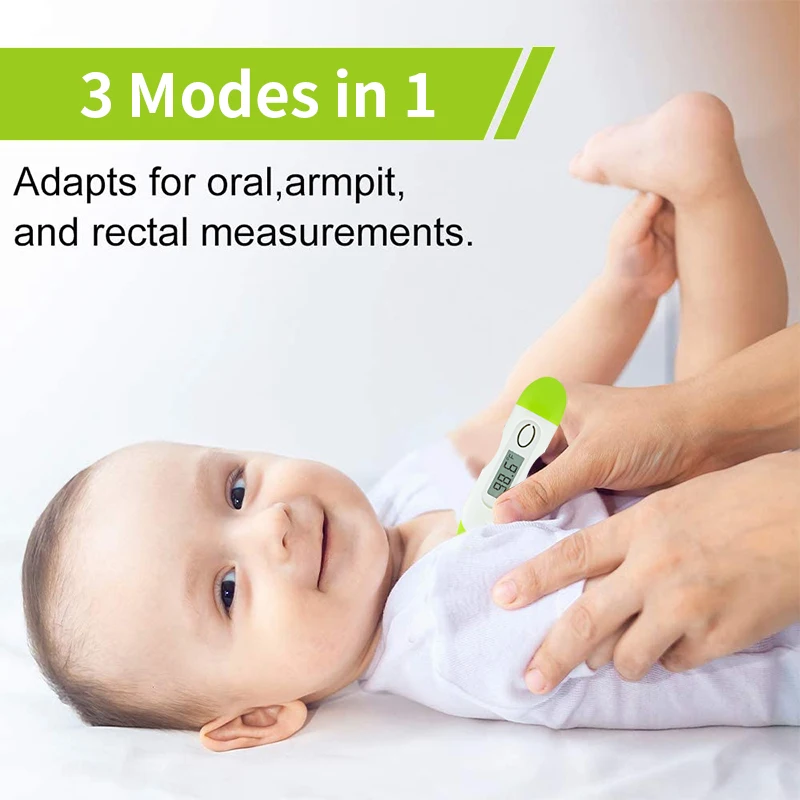 6 degrees as an indicator of health, and if the figure tends to 37, this can cause alarm. In fact, the norm varies, especially in children. According to the clinical guidelines of the Union of Pediatricians of Russia, "when measured in the armpit, normal fluctuations in body temperature are 36.5-37.5 ° C." Rectal temperature reaches 37.6°C.
6 degrees as an indicator of health, and if the figure tends to 37, this can cause alarm. In fact, the norm varies, especially in children. According to the clinical guidelines of the Union of Pediatricians of Russia, "when measured in the armpit, normal fluctuations in body temperature are 36.5-37.5 ° C." Rectal temperature reaches 37.6°C.
The indicator varies not only depending on the measurement method, but also during the day. Fluctuations are 0.5–1.0 ° C, the largest figure on the thermometer can be seen in the evening, by 19 o'clock.
It is possible to talk about fever if the child's temperature exceeds:
- rectal - 38.0 °C;
- oral - 37.6 °C,
- in the armpit - 37.4 °C;
- tympanic (measured with an ear thermometer) - 37.6°C.
You can measure the temperature in children (as well as in adults) using a thermometer. We talk about the main types, their pros and cons.
We talk about the main types, their pros and cons.
1. Mercury thermometer
A classic and most familiar device for measuring temperature.
Pros:
- Accurate and reliable. Its results can be trusted one hundred percent. Permissible error in the readings of the device is 0.1 degrees. Haven't come up with anything less yet.
- Cheap price of a mercury thermometer.
Cons:
- The main disadvantage is the duration of the measurement. To get an accurate result, you need to calmly hold it under your armpit for at least 5-7 minutes.
 Explaining this to children can be difficult.
Explaining this to children can be difficult.
- You cannot call a safe mercury thermometer. It is made of fragile glass, and glass can easily break. Sometimes one awkward movement is enough for the dangerous mercury content to be released. Not to mention the fragments themselves.
- Babies should never be trusted with such a thermometer. Only under the strict supervision of adults.
Method of measurement: axillary, rarely oral.
Geratherm Classic mercury-free galistane thermometer
667₽ 850₽
379₽ 499₽
260₽ 1,765₽
Thermometers are a modern alternative. Outwardly, they resemble ordinary ones, but inside they contain an alloy of metals (for example, gallium, indium and tin). There is no risk of mercury vapor poisoning, while the measurement accuracy is maintained.
There is no risk of mercury vapor poisoning, while the measurement accuracy is maintained.
2. Electronic thermometer
The main competitor of the mercury thermometer. The main advantage of an electronic thermometer is safety.
Pros:
- Does not break (only if you try to break it very hard and purposefully), does not contain dangerous mercury.
- Takes temperature quickly: in just 30-60 seconds. True, there are models with which you will have to sit for a couple more minutes even after a sound alert. But in any case, it is faster than measuring the temperature with a mercury thermometer.
- The result is displayed on the screen, which is also convenient.
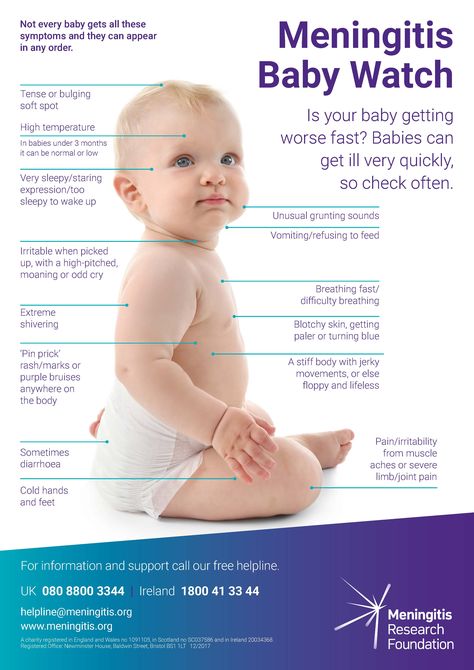 Especially in the dark: there is no need to illuminate the device, trying to see the result, as is the case with a mercury thermometer.
Especially in the dark: there is no need to illuminate the device, trying to see the result, as is the case with a mercury thermometer.
Thermometer OMRON ECO TEMP BASIC MS-246-RU, Electronic Medical
571 Rhesi 816 Rhesi
270 Rhesi 360 ₽
223 Rhesis 1 175 ₽
9000
- SHIRI can not. This is especially true of little-known manufacturers.
- The need to change batteries can come as a surprise at the most inopportune moment.
Measurement method: oral and axillary. And models with a special soft tip can also be used rectally, which is very convenient with babies.
3.
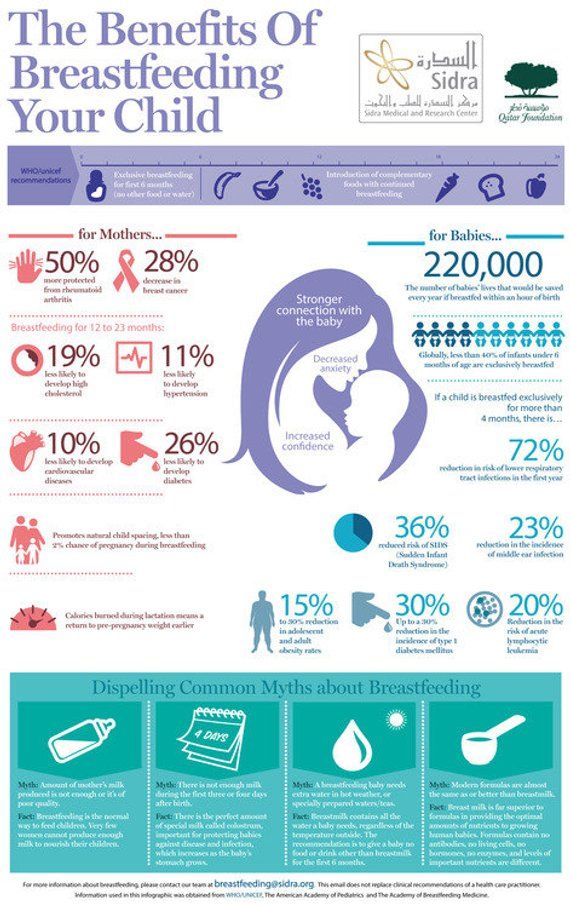 Infrared thermometer
Infrared thermometer New generation thermometer. The fastest of all: measures the temperature in just a few seconds. There are contact models (they need to be applied to certain points of the body) and non-contact ones (they do not need to be applied: just point them at the patient).
Pros:
- You can measure the temperature with an infrared thermometer even in a dream without disturbing the baby.
- Can be used not only to measure body temperature, but also water, air and even surrounding objects. For example, jars of puree.
Baby Digital Infrared Thermometer, Body Temperature Meter, Front, Ear, Non-Contact, Pediatric & Adult0₽
653₽ 2,990₽
Cons:
- The error of the thermometer can be quite high: 0.
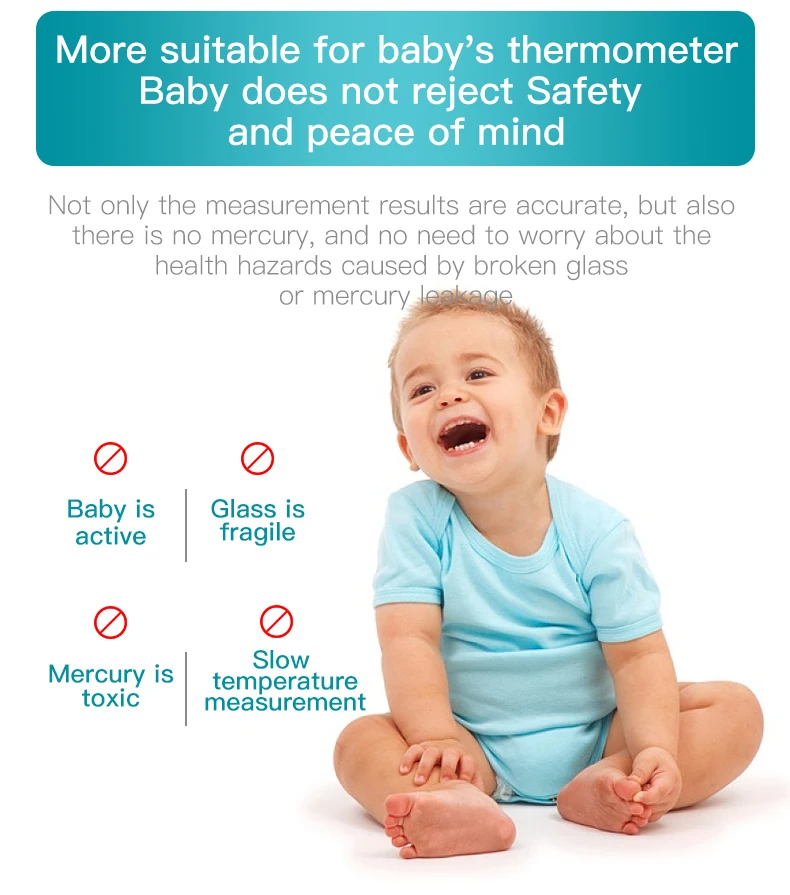 4–0.5 degrees.
4–0.5 degrees.
- The price of such a device is higher than other thermometers.
- Use the infrared thermometer on certain parts of the body. These are the ears, temples and neck. Otherwise, the result may be false. It can also be incorrect if the baby has an ear infection, this should not be forgotten either.
Measuring method: contact and non-contact frontal, ear and temporal.
4. Thermometer pacifier
Another state of the art. Outwardly, it resembles a traditional pacifier, at the base of which a sensor is built in to measure body temperature.
- The result is shown on the display at the same time as the alarm signal. For children who are "friends" with nipples, this is a great option.

Digital baby pacifier thermometer
599 ₽ 968 ₽
377 ₽ 980 ₽
361 ₽ 490 ₽
disadvantages:
- During illness, it happens that a baby and a favorite nipple are not happy: it may scream, capricious and span out the device. Therefore, a more traditional fallback should be on hand.
- The remaining disadvantages of the dummy thermometer are approximately the same as those of the electronic one: possible error and dependence on batteries, which often run out at the most inopportune moment.
- In addition, not all thermometer pacifiers can be disassembled and disinfected. Therefore, when choosing, give preference to models with removable nipples.
Measurement method: oral.
5. Thermal strips
Another option that will help you quickly and painlessly find out if your child has a temperature. To do this, it is enough to bring the strip to the forehead for 10-15 seconds, and then decipher the result. If it is elevated, then the strip will change color or display the result - it depends on the sensitivity of the thermal test. The simplest ones are divided into only two scales: normal temperature and elevated. There are also more sensitive options with an interval of 1 degree. Numbers are displayed on such strips: 36, 37, 38, 39.
- Thermal strips can come in very handy on the road and on a walk: they do not take up much space and weigh almost nothing.
Thermometer strip is a non-retarded safe flexible reusable set of 3 pieces
219 ₽ 285 ₽
526 ₽ 631 ₽
minus:
- The main disadvantage of this thermometer is a large dimension of measurement.
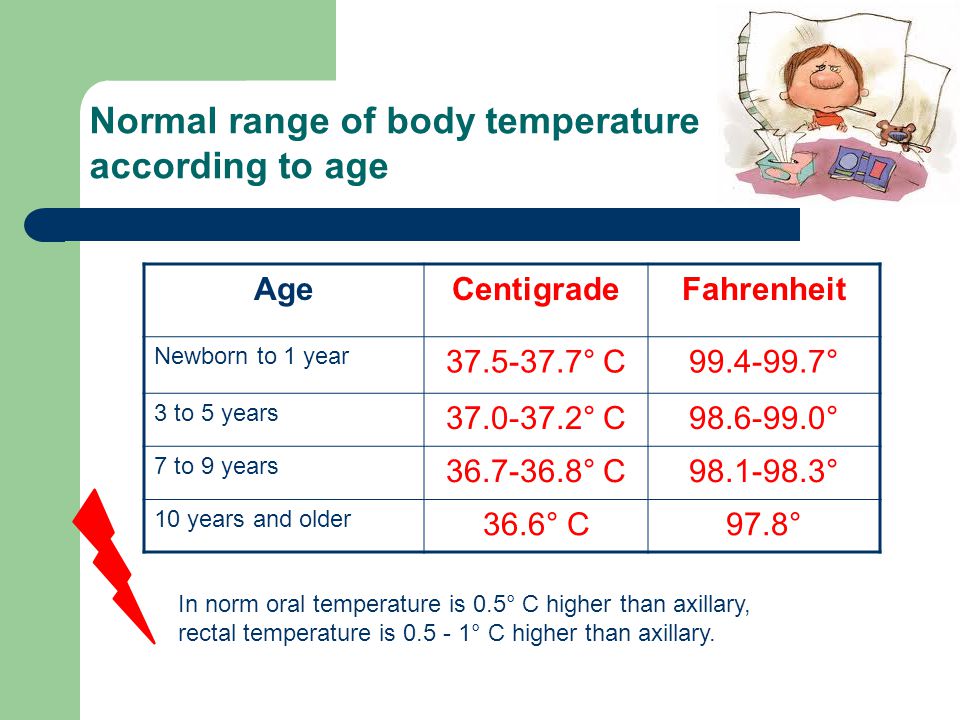 The test cannot accurately determine body temperature, it only signals whether it is elevated or not.
The test cannot accurately determine body temperature, it only signals whether it is elevated or not.
Measurement method: frontal contact.
How to take a child's temperature: methods
Not only thermometry devices differ, but also the methods of using thermometers. To get an accurate result, it is important to follow the basic rules.
Axillary method: under the arm
The thermometer is placed under the arm of the child who remains in a calm position. The armpit should be dry. The thermometer is pressed against the body and wait at least 5 minutes or until a beep sounds.
Rectal method: in the rectum
The tip of the thermometer is washed or rubbed with alcohol, then rinsed with water. Apply Vaseline or other lubricant to the tip. The child is placed on his stomach on the knees of an adult or on his back, pressing his legs to his chest. The thermometer is driven 1 or 1.5 cm into the anus.
Oral method: in the mouth
Disinfect the thermometer. Place it under the tongue, pointing the tip towards the back of the head. Ask the child to close their lips and hold the thermometer until the signal or about 3 minutes. Suitable method for older children.
“It is necessary to measure the temperature in this way 30 minutes after eating hot or cold food,” notes the specialist of the DocDeti clinic, pediatrician, Ph.


